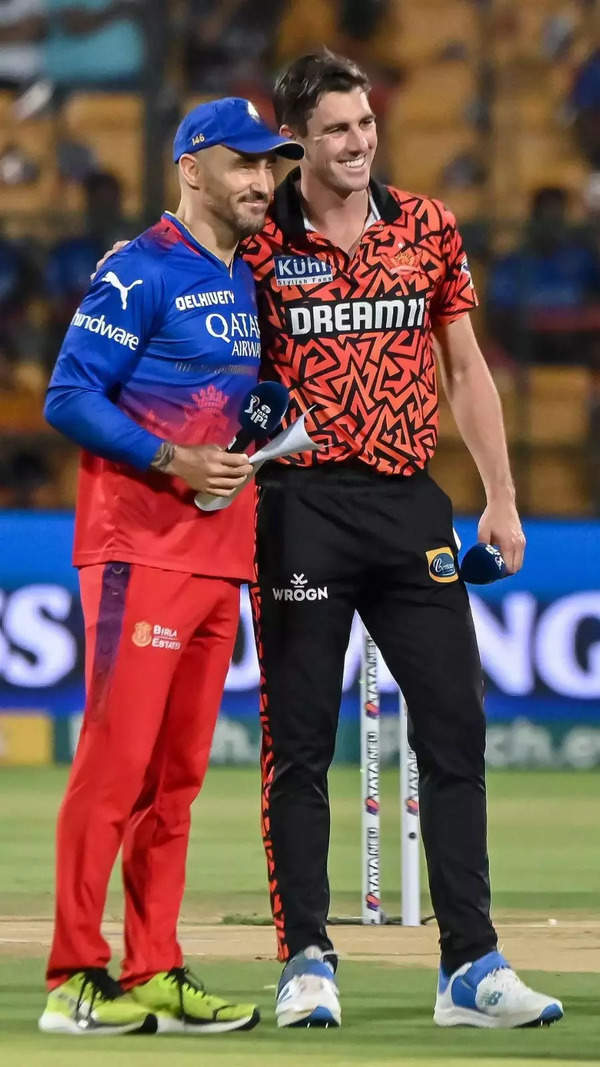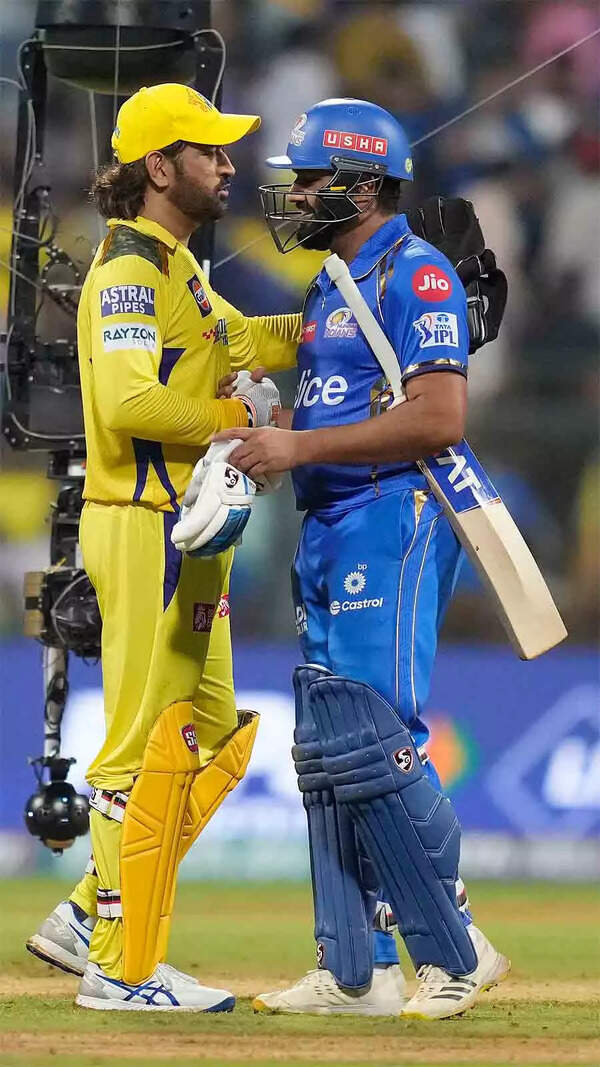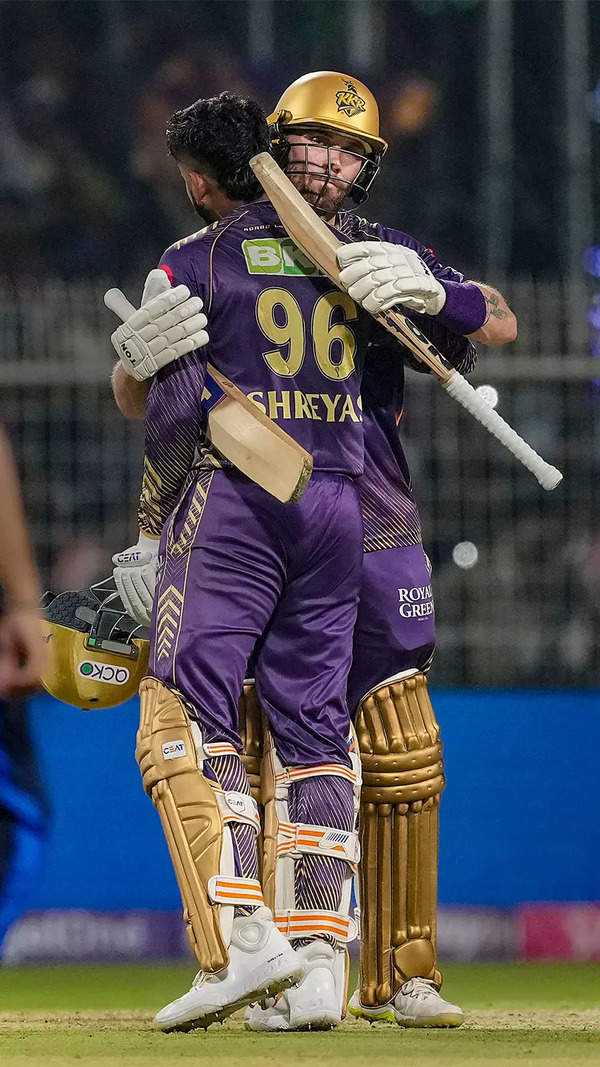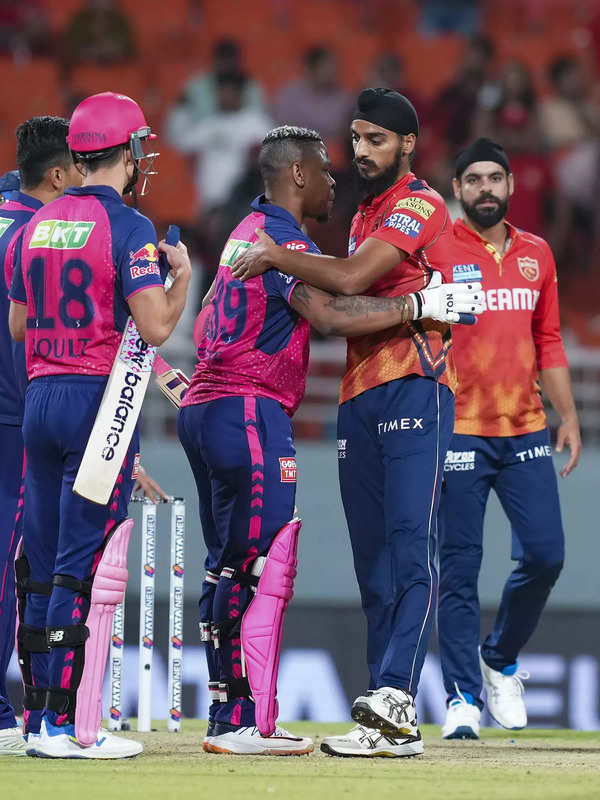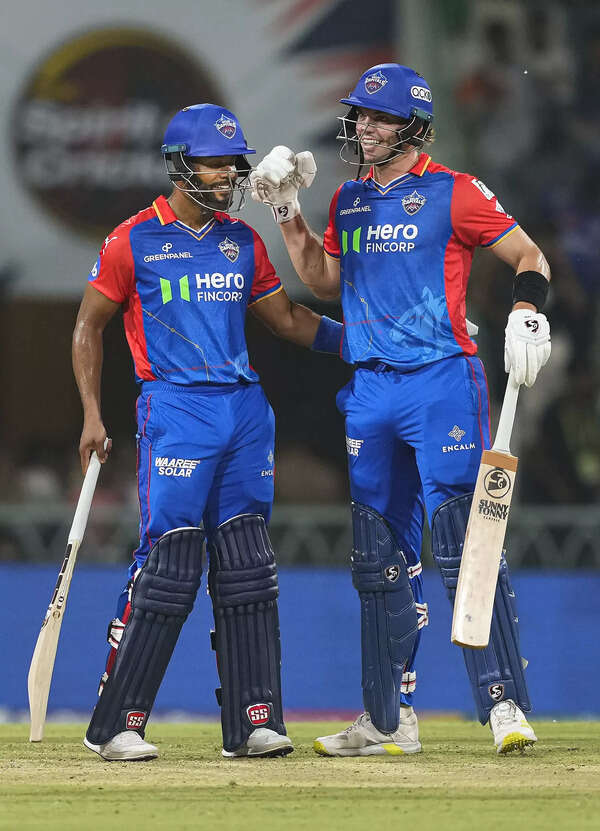- News
- Sports News
- Cricket News
- Brian Lara was slightly harder to bowl to than Sachin Tendulkar: Glenn McGrath
Trending
This story is from February 28, 2020
Brian Lara was slightly harder to bowl to than Sachin Tendulkar: Glenn McGrath
As a pace-bowling legend Glenn McGrath visited the TOI office in Mumbai on Thursday and played another role, that of a Guest Sports Editor. He spoke on a range of issues. McGrath said, "When it was his day, he could do absolutely anything. Sachin was equally as good, but there was something about Brian...he was slightly harder to bowl to than Sachin.."
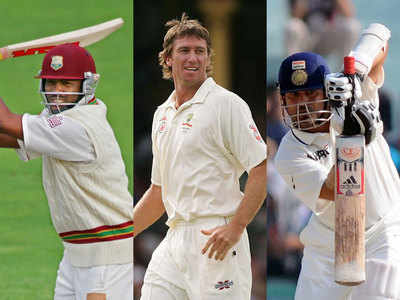
Brian Lara, Glenn McGrath and Sachin Tendulkar. (Getty Images)
Corporate speaker, pace-bowling guru at MRF Foundation in Chennai, tourism ambassador, proud owner of one of the biggest cancer foundations in Australia... Glenn McGrath dons many hats with élan.
However, it is as a pace-bowling legend that the man from the country town of Narrowmine - who went from sleeping in a caravan to having the best batsmen in the world for toast - that the recently-turned 50 (February 9) cricketer is known for.He visited the TOI office in Mumbai on Thursday and played another role, that of a Guest Sports Editor. He spoke on a range of issues.
Excerpts:
Glenn, what keeps you busy these days?
Now, I am over here in India for a couple of days, doing some stuff for Tourism Australia. I want to let all of India know that Australia is open for business. Come for a visit. Explore what the country has to offer from the Great Barrier Reef, the desert, the tropical rain forest and visit the major cities. Life's going okay.

How is Australia recovering from the recent bushfires?
All the fires are out now. We had some very decent rain. So those areas are in recovery now and looking good. It was as big as it was when you think about the size in respects to Australia, which is a massive country. The majority of Australia was affected. I think people who were watching it from overseas were probably thinking that the whole country was burning, but we're just letting you know that it's not. But the thing that comes out of it to me is just the show of support and the generosity of people in the way they came together as a community and supported the people in need. And I think that's very special. And I think that's great about Australia.
Which are the places in Australia that you recommend for a visit?
We've got two T20 World Cups happening, one at the moment with the women and the men a little later in October, and obviously then the Test series against Australia versus India, which is always a big one. So, you know, come out, see the major cities, the cricket grounds, the beaches, Kangaroo Island and the vineyards near Adelaide.
To me life is about experiences. So when people come to Australia, take a little bit of extra time and experience the country. I recommend everyone to come to Australia, watch Australia or India playing the final of both tournaments. I won't give her a prediction of who's going to win those because it might not go down too well. (Laughter)

The Southern Stars have won the T20 World Cup four times, but the men still have not got their hands on the trophy. Do you think that can change in October?
It's going to be interesting. Australia are at home. They are a pretty good team. They've just had another big win over South Africa overnight. So if they can keep that form up and take it in, you never know, but it's still a long way away.
The women are going for the fifth title. They're looking good against Bangladesh at the moment, but they still have to qualify, whereas the Indian girls have qualified. But we don't want to peak in the first match. You want to build it up and peak for the final. Fingers crossed. But now I'm looking forward to the fact that there's a standalone women's tournament now which is big for women's cricket.
The final is on Women's Day on March 8 at the MCG. It's going to be pretty special. We are coming out saying fill the MCG. We want as many people as possible. I think the previous world record for a women's sporting event anywhere in the world was in the US where China played against US in a football match. They got just over 90,000 people. So if I think it'd be brilliant on International Women's Day as well, if we can set a new record in Australia.
You just turned 50 on February 9. Do you feel like a 50-year old?
Yes, it's my third 50 (laughter). I got one for Worcester, one for Australia. So, I'm on track to get my first hundred. So we'll see how we go.

You had a batting average of less than 10 though...
Yeah. So it makes my 61 (vs. New Zealand at Brisbane) even more special. I tried to explain to Ricky Ponting and said my batting average was six and I scored 61 (more laughter).
I'll put it in terms of Sachin. Okay, Sachin averages over 50. So for me to score 61 would be like Sachin scoring over 500 in one innings. But then I only scored 640 odd runs in my career, which is nearly 10% in one innings. How many runs did Sachin score in his career? I know Ricky was just shy of 14,000.
So to break it down even more, that was like Sachin scoring 1500 runs in an innings.
How do you feel about turning 50 though? Because, you know, you're, an elite sports person and athletes have this image of being forever young.
When I turned 40, it wasn't too bad. Then when all my friends started turning 50, it gets a little scary. Not sure it's sunk in. You know, you never feel any older. The mind is still willing; maybe the body's not quite as willing anymore. I don't feel any older than when I was quite until I look in the mirror.

Your career - 563 wickets in 124 Tests and 381 scaps in 250 ODIs, is a lesson in longevity…
There were a few things that held me in good stead. I had a pretty good, fairly repetitive and stress-free action. I had a very short delivery stride, which meant I can stay tall and power up, but it meant I wasn't going to ball hundred miles an hour, unfortunately. I trained really hard. I came back in the team during the West Indies tour in '95 after an injury. I just made my place in the team for the first time, and I weighed 77 kilos. So, I was as tall as I'm right now…very skinny and injured. And I thought if I keep doing what I'm doing, I'm not going last very long. So I went out and found a trainer, Kev Chevell.
His philosophy was to train me so much harder than anything I'd experienced out in the middle, playing. I used look forward to the season starting just to have a rest. I think that sort of set up my work ethic. I had good genetics too. My grandparents were in an 'osteoporosis survey'. And they've got really high bone density. My bone density is really high too.
Importantly, I always liked to have an off-season too. At least every year, or every two years. It's similar to filling up your car with petrol. If you keep driving your car and don't top it back up, sooner or later, you will run out of fuel. And fast bowling is a little bit like that. Running in bowling, just bit by bit by bit each day. So, if you don't have an off-season to put that strength back in, sooner or later, you're going to pay the price for it.
Today, we have the IPL in a window where I guess most teams would have been resting in the past. Players, especially the fast bowlers need to make that choice of whether they need an off-season to top their strength up. Otherwise, the chance of getting injured goes up.
You said you had a fairly repetitive action. It's more like a workman-like approach…you come to the office and do the same thing for hours together. Is that what kept you going?
I had the confidence. Top of my mark, I knew exactly what ball I wanted to bowl. And I just used to start running in, relaxing, singing a song to myself… just switch off that little voice and just run in and bowl. I didn't want to bowl where the batsman wanted the ball, because I had good control. I was tall; I get a bit of bounce, a little bit of seam movement. I knew I could keep it in that spot all day, which also allowed me to have more fielders in the slips and catching areas. I felt I was running in hard and putting a huge amount of effort in every ball I bowled. But then I watched the replay on TV, and it looked like I was just jogging and rolling my arm over.

Did you make an effort to keep yourself angry?
More of controlled aggression I would say. If you had that controlled aggression, you had to be up for running in. The more I bowled, the better I felt. So you had to be up for the battle and win the challenge. It's funny. I hadn't missed playing since the moment I retired, until the other day, and I was thinking about: when you walk on the field, and go in front of a big crowd, and experience that atmosphere, the noise, it's an amazing feeling and standing at the top of your mark, ready to bowl that first ball or even in the pressure situation of you know, the death overs of an international match. That feeling, you can't replicate in any other form of life. And if I miss anything, it is that. I love pressure. It made me relax and feel even more comfortable.
How difficult was it to break into the Australian team? Your coach and even your captain said that the fishing rod is more talented than you…
I grew up in a small country town called Narrowmine (New South Wales) and left it 30 years ago. It had 3,000 people and it still has that many. I just played cricket because I loved it. I had a certain self-belief in myself… certain confidence. I was happy with whom I was as a person and I was happy to spend time by myself. So, I was comfortable in my own skin. And I didn't listen to these people. When I first moved to Sydney, there were plenty of people who said that I was wasting my time, because I was only just good enough for Narrowmine. I didn't play much under-age cricket. But I just played because I enjoyed it. And I moved to Sydney to give it a go. And then after attending the cricket academy in Adelaide, I realised that what it meant or take to be a professional cricketer. That was a big turning point for me. I knew exactly what I had to do. I knew exactly how to go about it. And I had no doubts. I wouldn't cheat. So that clear path with that confidence, helped me. And of course, that was not a bad Australian team to play in, was it! Within four years moving to Sydney, I was playing for Australia. I don't hold any grudges. I was pretty relaxed and focused on what I wanted to achieve. I had self-belief and was prepared to work hard and was always looking to improve. My goal was to play the perfect game where every single ball went exactly where I wanted it to. I got close in one One-Day match against New Zealand, where I reckon 59 out of 60 balls were exactly where I wanted them to land.

Why is fast bowling such a difficult art?
It's just the nature of the beast. Being a fast bowler is tough on the body without a doubt. You've got to be prepared to put the extra work in. You've got to be prepared to work harder and longer than anyone else in the team. And then it's about recovery and getting yourself up ready to go the next day. I guess I was one of the lucky ones, where the more I bowled, the better I felt. Whereas some guys, the more they bowled, they get tired, they get sore. But because I had a fairly stress-free action, it all helped. It's just the nature of the beast. We put so much stress on our body every single ball we bowl. The chance of getting injured is high.
We heard stories about bowlers keeping a coin on the pitch and trying to hit it. Were there things like that that you did to develop that accuracy?
It was all about feel for me. Just feel about bowling the right length, and that right length is not the same every single pitch. It's being able to adapt and adjust. It comes down to execution. So on a pitch that's doing a little bit more, you know 'okay, I've got to get a little bit fuller'. And you've just got to vary that length depending on the conditions. So I used to practise just hitting the top of off stump. I've never put a coin on the pitch or anything like that. But it was just a feel thing.
I do like target practice. At the MRF pace Foundation, we do a bit of that, where we put a cone on a good length, or a cone on a Yorker length, cone on a bouncer length and they've got to hit it and then get two teams and make it competitive. And it's amazing that the pressure that's on the boys doing that in front of their peers, if they can do it there in a match, they can do it at will. So we try to make it as tough as possible. But you can train yourself to bowl those good areas and be confident in yourself that you're going to do it.

You talked about singing a song in your head, did the song ever change?
I'm not very good at singing out loud. But singing a song to myself just in my head, whatever was on the radio that day, or whatever I listened to at that time, it was just the way to switch that little voice off. Yeah, I'd tell myself, 'I know how to ball; all I need to do is relax, run in and bowl. And so, just as I'm running in and bowling, just singing a song in my head, everything's locked in. I don't need to think, just relax and bowl.
Which was the song you sang in your head when you took 8/38 at Lord's?
That was back in 1997. I can't remember what happened a week ago. I'd have to go back through the top 10 songs at that time and see if there's something there. But yeah, it was never a specific song or anything like that, it was just whatever I was listening to just helped me relax.

What was a bad day at the office for you like?
I worked out the difference very quickly between why I had a good day and why I had a bad day. When I had a good day, I was just relaxed, running in bowling. I wasn't overthinking, I wasn't worrying about my action; I was just worrying about where I was pitching the ball. When I had a bad day, it felt like I'd forgotten how to bowl. It feels like it was coming out so slowly and the action felt terrible. So I'd just try to tell myself 'relax, just think about only where I want that ball to land'. And I'd run in, try to sing a song and after an over or two, all of a sudden I was back having a good day. So that was the difference, and I think all young cricketers, and especially young bowlers, need to work that out. It's good to know why you have a good day but also know why you have a bad day. And if you could work both those out, you can actually turn things around very quickly.
Going into a game could you sense that?
You can sense it because yeah, you feel terrible (laughs). But I used to use a wicketkeeper as well. I'd go down to Gilly asking 'just have a look. Next over, just see if you see anything different with my action', because he's the one there that watches it day in, day out. And he'd say 'nah, it looks good'. Or if I came off at lunch or tea, I'd just have a look at a bit of video footage. It actually looks the same and that allowed me to relax. So it was just having that confidence within me that I knew the process to turn things around.

When you were coming back to international cricket from injuries, did you prefer going through the Sheffield Shield route? There was this controversy recently with Jasprit Bumrah not playing a First Class match and was straightaway back in the Indian team. He hasn't been at his best…
It's interesting. There were a lot of times that I came back straight into international cricket without playing any state cricket. It just depends if it's the start of the season or where things are at. Coming back from injury is like starting the season over again. And it took a little while. I'd finish the season up here (gestures). And the first game next season, I wanted to start back there. But it doesn't work that way. And the first few years, I'd get annoyed and it would impact my performance. Then I realized, to get back there I've got to start from here (gestures). And I'm going to take it easy on myself. Just build it up and after a few games, I should be getting up there. It's just about knowing yourself, and that sort of helped me.
Whether coming back through Shield cricket would have helped, I don't know. Maybe, maybe not, because they are different pressures. You come back in Shield cricket; you're expected to take wickets. You have different expectations on yourself at state level than you do at international, which is wrong. So we need to get our mind and thought processes in order. So with respect to Jasprit, as long as his thought processes are good, he's not feeling the pressure of expectations, he's not thinking 'I'm coming back in here. I've got to build it up. I've got to take a little bit of time'. Just concentrate on getting the ball in the right area, get the feel of it coming out, bowl at reasonable pace and the wickets will come. And that's where he needs to get back to at the moment. As soon as he does that, pick up a wicket or two, and he's away.
How do you rate Bumrah as a bowler?
He's a quality bowler. I like the way he goes about it. I like his action. It's very unique, there's no doubt about that, but it's been very effective for him. So whether he should have come back through state level, yeah it's a tough one. Next game he comes out and takes a five-for, everyone's happy aren't they? We're very result-orientated when it comes to the public and to the media, whereas as a cricketer, you've got to be very process-orientated. And if you're comfortable and happy with the way you're bowling, but not taking wickets, that was fine. I knew wickets weren't far away. So it's just your thought processes, and I think for Bumrah, maybe, that's where he's at the moment.

There's so much talk about his action. How much of a toll does it take on his body?
It probably takes a little bit because to generate that pace, you have to put in more effort, especially off a short run. The thing that Jasprit has in his favour is the last few steps of his run up, he actually generates and powers through the crease, and then he's got a really good follow through.
You see guys with short run ups, they try to muscle it, do it all at the crease, and then they have a very short follow through. So the fact that Bumrah, sort of, powers through the crease in his last few steps and has a good follow through is what holds him in good stead. The fact he can come back in his second and third spells and bowl just as quickly is a testament to that.
Whether if he had a longer run, yeah, it may save that little extra energy every ball - maybe, maybe not, maybe he wouldn't be able to bowl as well, who knows? But that's how he works at his best and I think he had a couple of years or more without any injury. So that itself tells me his action's fine. So whether he had an opportunity to have an offseason and put a bit of strength back in, I don't know. But he's a quality bowler and he is definitely unique, but he's found something that works for him.
Why were you nicknamed pigeon?
I was playing a game for New South Wales. And there were a couple of guys Brad McNamara, who played a lot of cricket for New South Wales and Greg Matthews, and Mike Whitney, who played for Australia. I think all three of them have taken credit for that nick-name. But they'll carry on saying that my legs were that skinny that they resembled a pigeon's.
So a stupid comment like that and it's stuck ever since. And that's been my nick-name. Before that it was Millard. And that was only because when I moved to Sydney, I lived in a caravan. And the type of caravan I lived in was a Millard. So not two very strong, aggressive names for a fast bowler. But you can't pick your own nick-name. And it's just one of those things that stuck.

What kind of a role does biomechanics play?
It didn't play a huge role. Back then it was there more for people who were injured and coming back from injury or who had actions that meant the possibility of getting injured but I think it's important to a degree that slowly your hips and your shoulders are in line when you bowl and your energy's going forward towards where you want to bowl and everything's pretty well.
Everyone's got to have it. Everyone's got their own action. We don't want robots running in bowling exactly the same, but the basics are all very similar. So biomechanics are important. But if you've got the perfect action, and you can't take a wicket, or you've got the worst action in the world, you can bowl all day at top pace, never get injured and you take heaps of wickets, who cares?
And there's the thing about multiple formats…
Yep. I quite enjoy playing all three formats, even though I played only a handful of T20 matches. They all require a different thought process, different planning.
If you can land the ball where you want to land it 99 times out of a 100 then you're going to be successful. In a Test match it's about building pressure, getting that ball in that same spot. T20 cricket is about containment. And then at the death, being able to bowl slow balls, bowl yorkers.
You've got to be able to mix it up. Three yorkers, two slow balls, a bouncer and a wide length ball. Yeah, it's all about execution.

You think The Hundred starting next year will succeed...
It's interesting. I'm curious why they decided to bring a total new format with new rules. And maybe it's the English trying to do something. But it's going to be interesting to see how it goes.
I am very much a traditionalist. Test cricket is still the ultimate for me. I enjoy One-day cricket and Test cricket. I understand T20 cricket is quick, it's exciting. It's about bringing people to the game. And if we can bring more people to cricket then it's great. Hopefully, that will filter up to Test cricket. The Hundred it's basically another format similar to T20 but with only 100 balls. So yeah, that's changing the fabric of the game.
Does it add to the complications to an already complicated game?
If we bring in The Hundred as well, you've got Test cricket, you've got One-day cricket, you've got T20 cricket, and now you've got 100-ball cricket. Now try explaining that to an American who can't understand cricket.
Cricketers are hero-worshiped in India. Do you think there is a fear of failure among them because of the kind of pressure to perform?
Here in India definitely but back home we are just normal people. I could walk around the streets back home and nobody worries me. Even Sachin went for a walk there recently and nobody bothered him. He could probably walk down the street without too many issues.
So they do hold their sportspeople in Australia in high regard. But not like cricketers here in India. Yeah, cricketers are superstars over here. And even for visiting cricketers. I suppose there is more pressure on the cricketers over here. If Australia loses, there's not too much fuss back home or maybe just a little bit. Whereas over here, it's, you know, when you've got 1.3 or 1.4 billion people. It's a little bit more pressure than 25 million people. Yes, there's more pressure on Indian cricketers. But the rewards are a lot more than anyone else.
You faced the brunt of Indian fans when you got Sachin out with that LBW in Adelaide. You also apparently got death threats after Darryl Harper gave him out…
Yeah, it's a shame that they didn't have the DRS back then. So what had happened there was that Sachin had just come in. I don't think he had scored at that stage. He was still on zero. I tried to bowl a bouncer and unsettle him. And it didn't get up. It kept low. And Sachin is not the tallest player at the best of times. And he ducked and the ball hit him on the shoulder. And from where I was looking, I thought it's hitting the stumps. I could see the bails over his head. So I appealed and the umpire gave it out. I still think it's out. Sachin still thinks the ball was clearing the stumps by a ball and a half. So back in the old days when the umpires gave it out, that was it.
Then we went to Melbourne and Sydney for the Tests yeah, I got a few death threats. I had security. My family had security in Sydney because Cricket Australia received death threats for me, because I got Sachin out. It was an unusual freak dismissal.

Did you discuss it with Sachin in your meetings with him after all these years?
We had a function few years back at MRF where Sachin came and spoke to the boys and then we had a Q&A session and one of the questions was about that dismissal, and I was still adamant it was out. He too was sure about it and said he was not out. Some people said you've got to get hit in the leg to be leg before wicket and shoulder doesn't count (laughter).
You have never been a fan of DRS?
I would have probably taken more wickets with it. When the DRS first came in, I was also a fan of it. I liked it, but now that I've seen it in use, and it's used for everything, but the way it was designed for, and I guess that's human nature isn't to find different ways to do things. And DRS now is a tactic.
Yeah, you're going to win and lose Test matches based on how well or how badly you used DRS. And I disagree with that. But that's modern-day cricket. Until we get it in exactly black and white, which I don't think we ever will, there will be issues.
How concerned are you about the health of Test cricket? Do you still feel there's a viewership for it among cricket fans?
I like to think there is. I speak to a lot of Australian cricketers and they still hold it in high regard. I think English cricketers think the same too. If Indians love Test cricket, it will survive at the end of the day, just because of the passion and the sheer number of people and how they feel about cricket in this country. So, when T20 cricket first came about, I was concerned that it would have a negative impact on Test cricket. And I remember in the second Indian Premier League in South Africa, I was sitting having a chat with Matthew Hayden, and I mentioned my thoughts and he said he actually looked at it from a different perspective. He thought T20 cricket had the potential to bring new people that don't watch cricket to the game, had the potential to take cricket to countries that don't play cricket. And it was a way that we could really grow the game. And once these people got interested in cricket, it would filter up to Test cricket. So I think that's a real possibility, but it's going to depend on the on the Boards and on the players themselves. If you've got young cricketers coming through still wanting to represent the country playing Test cricket, then I think it'll be healthy. If young cricketers just want to play T20, or go for the dollar, the glamour and everything else that goes with it, it may struggle a little bit, but we've got to keep it fresh and moving forward.
I'm not a big fan of the idea of having four-day Tests. I like the five days but I do like the day-light Test cricket. I think the way it's worked in Australia and the way it was supported, and the way people have come to the game. I think that's one way we can keep Test cricket moving forward and keeping it fresh and alive and, and I'm happy that Virat's agreed to play the Day-Nighter in Adelaide, later this season.
What are the lessons you take from the ball tampering saga?
It's interesting. We've always shined the ball. And I think that's the limit. I don't agree with rubbing the ball on the ground. I don't agree with putting mints on the ball. What happened in South Africa is definitely the wrong thing to do. It's up to the ICC to make a ruling on that and to be similar across the board. I know the Australians learnt a hard lesson. Hopefully other countries have as well.
Who do you think among the current crop are the top three bowlers?
All Aussies. Pat Cummins, Josh Hazelwood and Mitchell Starc. (Laughter). But seriously, Pat Cummins, Jasprit Bumrah and Kagiso Rabada. I like Neil Wagner too.
Aussie sport sometimes is seen as overly aggressive. Do you think that's a characteristic they should retain?
It's the Australian way. As players, we've probably don't look overly aggressive. We play hard in the middle. But it's always been a mantra to play hard but fair and as soon as you walk off the field, you're mates again.
If you think Australians play hard against other countries, wait till you see Australia play Australia or mates play against mates. Then you've got some aggression. You want to see good, hard cricket.
Look at the way Virat goes about it. I want people to go out and show emotion. I like aggression but controlled aggression. I don't want to see robots running around showing no emotion. But there is a fine line there. And we have to keep to that line.
A few people said I was quite aggressive when I played. I think there's a line there that should never be crossed. Bit of chat is fine. When it comes to abuse or getting personal, there's no spot for that in world cricket, or any cricket at all, but a little bit of friendly banter is always good.
Sledging, I think is the wrong term. It just sounds bad. And it's never as bad as anyone says it is. So we should use Steve Waugh's term which is gamesmanship or mental disintegration (laughs).
The Aussie team in the early 2000s was one of the greatest. Did you'll have any realisation that you'll were something great. What was the feeling in the dressing room?
I guess yeah, while you're playing, you'd never consider yourself a great team or anything like that. But there were some big personalities in that team and any one of the 11 or 13, on the day could win the game. And that's fairly rare. Most teams had two or three guys that have that X Factor. I think that Australian team then had the whole team and a really close knit team. And I think one of the secrets to our success was, not only did we enjoy our own success, we enjoyed our teammates success just as much. And if you've got that in a sports team or a business team, you're going to be successful. We backed ourselves and never feared losing. In the changing room it was good. We had Warnie (Shane Warne). He was here (high level) while the rest of us were here (mid-level). We accepted that. I think Shane accepted that and we got along well.
Brian Lara scored more runs in Australia when you and Shane Warne were both in the eleven than Tendulkar. Was he harder to bowl to?
That was Brian. He never changed his game. I may have got him out 15 times, but he also scored big hundreds and double hundreds against us when both me and Warnie were playing together for Australia. When it was his day, he could do absolutely anything. Sachin was equally as good, but there was something about Brian where he could just keep going and he was slightly harder to bowl to than Sachin. He was more fearless.

However, it is as a pace-bowling legend that the man from the country town of Narrowmine - who went from sleeping in a caravan to having the best batsmen in the world for toast - that the recently-turned 50 (February 9) cricketer is known for.He visited the TOI office in Mumbai on Thursday and played another role, that of a Guest Sports Editor. He spoke on a range of issues.
Excerpts:
Glenn, what keeps you busy these days?
When I played, cricket used to be the only thing to focus on. Now I have some sponsors. I do quite a bit of corporate speaking, commentating and coaching in India at the MRF Pace Foundation. I am also on a couple of boards; I have the McGrath foundation, family. So these things keep me busy.
Now, I am over here in India for a couple of days, doing some stuff for Tourism Australia. I want to let all of India know that Australia is open for business. Come for a visit. Explore what the country has to offer from the Great Barrier Reef, the desert, the tropical rain forest and visit the major cities. Life's going okay.

How is Australia recovering from the recent bushfires?
All the fires are out now. We had some very decent rain. So those areas are in recovery now and looking good. It was as big as it was when you think about the size in respects to Australia, which is a massive country. The majority of Australia was affected. I think people who were watching it from overseas were probably thinking that the whole country was burning, but we're just letting you know that it's not. But the thing that comes out of it to me is just the show of support and the generosity of people in the way they came together as a community and supported the people in need. And I think that's very special. And I think that's great about Australia.
Which are the places in Australia that you recommend for a visit?
We've got two T20 World Cups happening, one at the moment with the women and the men a little later in October, and obviously then the Test series against Australia versus India, which is always a big one. So, you know, come out, see the major cities, the cricket grounds, the beaches, Kangaroo Island and the vineyards near Adelaide.
To me life is about experiences. So when people come to Australia, take a little bit of extra time and experience the country. I recommend everyone to come to Australia, watch Australia or India playing the final of both tournaments. I won't give her a prediction of who's going to win those because it might not go down too well. (Laughter)
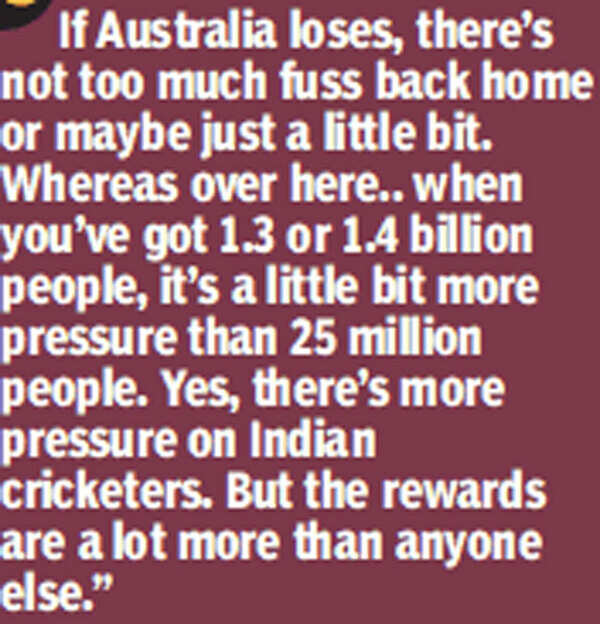
The Southern Stars have won the T20 World Cup four times, but the men still have not got their hands on the trophy. Do you think that can change in October?
It's going to be interesting. Australia are at home. They are a pretty good team. They've just had another big win over South Africa overnight. So if they can keep that form up and take it in, you never know, but it's still a long way away.
The women are going for the fifth title. They're looking good against Bangladesh at the moment, but they still have to qualify, whereas the Indian girls have qualified. But we don't want to peak in the first match. You want to build it up and peak for the final. Fingers crossed. But now I'm looking forward to the fact that there's a standalone women's tournament now which is big for women's cricket.
The final is on Women's Day on March 8 at the MCG. It's going to be pretty special. We are coming out saying fill the MCG. We want as many people as possible. I think the previous world record for a women's sporting event anywhere in the world was in the US where China played against US in a football match. They got just over 90,000 people. So if I think it'd be brilliant on International Women's Day as well, if we can set a new record in Australia.
You just turned 50 on February 9. Do you feel like a 50-year old?
Yes, it's my third 50 (laughter). I got one for Worcester, one for Australia. So, I'm on track to get my first hundred. So we'll see how we go.

You had a batting average of less than 10 though...
Yeah. So it makes my 61 (vs. New Zealand at Brisbane) even more special. I tried to explain to Ricky Ponting and said my batting average was six and I scored 61 (more laughter).
I'll put it in terms of Sachin. Okay, Sachin averages over 50. So for me to score 61 would be like Sachin scoring over 500 in one innings. But then I only scored 640 odd runs in my career, which is nearly 10% in one innings. How many runs did Sachin score in his career? I know Ricky was just shy of 14,000.
So to break it down even more, that was like Sachin scoring 1500 runs in an innings.
How do you feel about turning 50 though? Because, you know, you're, an elite sports person and athletes have this image of being forever young.
When I turned 40, it wasn't too bad. Then when all my friends started turning 50, it gets a little scary. Not sure it's sunk in. You know, you never feel any older. The mind is still willing; maybe the body's not quite as willing anymore. I don't feel any older than when I was quite until I look in the mirror.

Your career - 563 wickets in 124 Tests and 381 scaps in 250 ODIs, is a lesson in longevity…
There were a few things that held me in good stead. I had a pretty good, fairly repetitive and stress-free action. I had a very short delivery stride, which meant I can stay tall and power up, but it meant I wasn't going to ball hundred miles an hour, unfortunately. I trained really hard. I came back in the team during the West Indies tour in '95 after an injury. I just made my place in the team for the first time, and I weighed 77 kilos. So, I was as tall as I'm right now…very skinny and injured. And I thought if I keep doing what I'm doing, I'm not going last very long. So I went out and found a trainer, Kev Chevell.
His philosophy was to train me so much harder than anything I'd experienced out in the middle, playing. I used look forward to the season starting just to have a rest. I think that sort of set up my work ethic. I had good genetics too. My grandparents were in an 'osteoporosis survey'. And they've got really high bone density. My bone density is really high too.
Importantly, I always liked to have an off-season too. At least every year, or every two years. It's similar to filling up your car with petrol. If you keep driving your car and don't top it back up, sooner or later, you will run out of fuel. And fast bowling is a little bit like that. Running in bowling, just bit by bit by bit each day. So, if you don't have an off-season to put that strength back in, sooner or later, you're going to pay the price for it.
Today, we have the IPL in a window where I guess most teams would have been resting in the past. Players, especially the fast bowlers need to make that choice of whether they need an off-season to top their strength up. Otherwise, the chance of getting injured goes up.
You said you had a fairly repetitive action. It's more like a workman-like approach…you come to the office and do the same thing for hours together. Is that what kept you going?
I had the confidence. Top of my mark, I knew exactly what ball I wanted to bowl. And I just used to start running in, relaxing, singing a song to myself… just switch off that little voice and just run in and bowl. I didn't want to bowl where the batsman wanted the ball, because I had good control. I was tall; I get a bit of bounce, a little bit of seam movement. I knew I could keep it in that spot all day, which also allowed me to have more fielders in the slips and catching areas. I felt I was running in hard and putting a huge amount of effort in every ball I bowled. But then I watched the replay on TV, and it looked like I was just jogging and rolling my arm over.
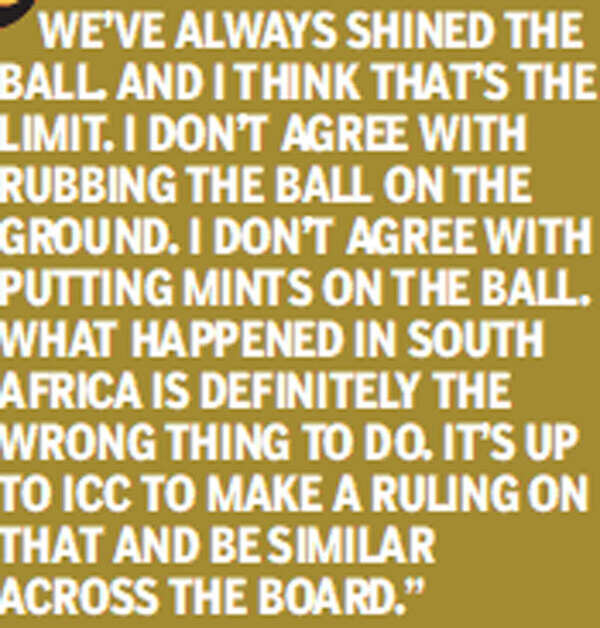
Did you make an effort to keep yourself angry?
More of controlled aggression I would say. If you had that controlled aggression, you had to be up for running in. The more I bowled, the better I felt. So you had to be up for the battle and win the challenge. It's funny. I hadn't missed playing since the moment I retired, until the other day, and I was thinking about: when you walk on the field, and go in front of a big crowd, and experience that atmosphere, the noise, it's an amazing feeling and standing at the top of your mark, ready to bowl that first ball or even in the pressure situation of you know, the death overs of an international match. That feeling, you can't replicate in any other form of life. And if I miss anything, it is that. I love pressure. It made me relax and feel even more comfortable.
How difficult was it to break into the Australian team? Your coach and even your captain said that the fishing rod is more talented than you…
I grew up in a small country town called Narrowmine (New South Wales) and left it 30 years ago. It had 3,000 people and it still has that many. I just played cricket because I loved it. I had a certain self-belief in myself… certain confidence. I was happy with whom I was as a person and I was happy to spend time by myself. So, I was comfortable in my own skin. And I didn't listen to these people. When I first moved to Sydney, there were plenty of people who said that I was wasting my time, because I was only just good enough for Narrowmine. I didn't play much under-age cricket. But I just played because I enjoyed it. And I moved to Sydney to give it a go. And then after attending the cricket academy in Adelaide, I realised that what it meant or take to be a professional cricketer. That was a big turning point for me. I knew exactly what I had to do. I knew exactly how to go about it. And I had no doubts. I wouldn't cheat. So that clear path with that confidence, helped me. And of course, that was not a bad Australian team to play in, was it! Within four years moving to Sydney, I was playing for Australia. I don't hold any grudges. I was pretty relaxed and focused on what I wanted to achieve. I had self-belief and was prepared to work hard and was always looking to improve. My goal was to play the perfect game where every single ball went exactly where I wanted it to. I got close in one One-Day match against New Zealand, where I reckon 59 out of 60 balls were exactly where I wanted them to land.
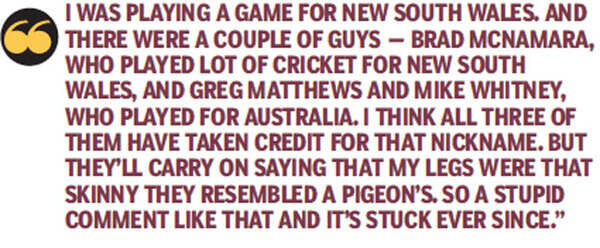
Why is fast bowling such a difficult art?
It's just the nature of the beast. Being a fast bowler is tough on the body without a doubt. You've got to be prepared to put the extra work in. You've got to be prepared to work harder and longer than anyone else in the team. And then it's about recovery and getting yourself up ready to go the next day. I guess I was one of the lucky ones, where the more I bowled, the better I felt. Whereas some guys, the more they bowled, they get tired, they get sore. But because I had a fairly stress-free action, it all helped. It's just the nature of the beast. We put so much stress on our body every single ball we bowl. The chance of getting injured is high.
We heard stories about bowlers keeping a coin on the pitch and trying to hit it. Were there things like that that you did to develop that accuracy?
It was all about feel for me. Just feel about bowling the right length, and that right length is not the same every single pitch. It's being able to adapt and adjust. It comes down to execution. So on a pitch that's doing a little bit more, you know 'okay, I've got to get a little bit fuller'. And you've just got to vary that length depending on the conditions. So I used to practise just hitting the top of off stump. I've never put a coin on the pitch or anything like that. But it was just a feel thing.
I do like target practice. At the MRF pace Foundation, we do a bit of that, where we put a cone on a good length, or a cone on a Yorker length, cone on a bouncer length and they've got to hit it and then get two teams and make it competitive. And it's amazing that the pressure that's on the boys doing that in front of their peers, if they can do it there in a match, they can do it at will. So we try to make it as tough as possible. But you can train yourself to bowl those good areas and be confident in yourself that you're going to do it.
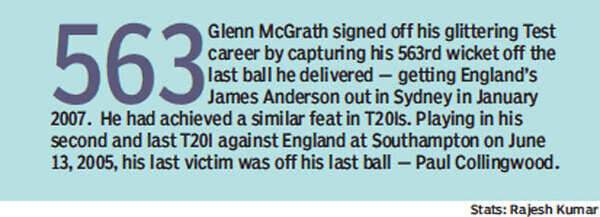
You talked about singing a song in your head, did the song ever change?
I'm not very good at singing out loud. But singing a song to myself just in my head, whatever was on the radio that day, or whatever I listened to at that time, it was just the way to switch that little voice off. Yeah, I'd tell myself, 'I know how to ball; all I need to do is relax, run in and bowl. And so, just as I'm running in and bowling, just singing a song in my head, everything's locked in. I don't need to think, just relax and bowl.
Which was the song you sang in your head when you took 8/38 at Lord's?
That was back in 1997. I can't remember what happened a week ago. I'd have to go back through the top 10 songs at that time and see if there's something there. But yeah, it was never a specific song or anything like that, it was just whatever I was listening to just helped me relax.
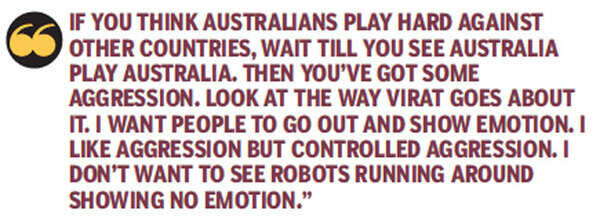
What was a bad day at the office for you like?
I worked out the difference very quickly between why I had a good day and why I had a bad day. When I had a good day, I was just relaxed, running in bowling. I wasn't overthinking, I wasn't worrying about my action; I was just worrying about where I was pitching the ball. When I had a bad day, it felt like I'd forgotten how to bowl. It feels like it was coming out so slowly and the action felt terrible. So I'd just try to tell myself 'relax, just think about only where I want that ball to land'. And I'd run in, try to sing a song and after an over or two, all of a sudden I was back having a good day. So that was the difference, and I think all young cricketers, and especially young bowlers, need to work that out. It's good to know why you have a good day but also know why you have a bad day. And if you could work both those out, you can actually turn things around very quickly.
Going into a game could you sense that?
You can sense it because yeah, you feel terrible (laughs). But I used to use a wicketkeeper as well. I'd go down to Gilly asking 'just have a look. Next over, just see if you see anything different with my action', because he's the one there that watches it day in, day out. And he'd say 'nah, it looks good'. Or if I came off at lunch or tea, I'd just have a look at a bit of video footage. It actually looks the same and that allowed me to relax. So it was just having that confidence within me that I knew the process to turn things around.
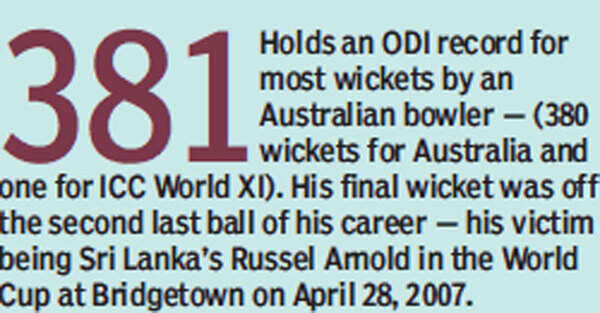
When you were coming back to international cricket from injuries, did you prefer going through the Sheffield Shield route? There was this controversy recently with Jasprit Bumrah not playing a First Class match and was straightaway back in the Indian team. He hasn't been at his best…
It's interesting. There were a lot of times that I came back straight into international cricket without playing any state cricket. It just depends if it's the start of the season or where things are at. Coming back from injury is like starting the season over again. And it took a little while. I'd finish the season up here (gestures). And the first game next season, I wanted to start back there. But it doesn't work that way. And the first few years, I'd get annoyed and it would impact my performance. Then I realized, to get back there I've got to start from here (gestures). And I'm going to take it easy on myself. Just build it up and after a few games, I should be getting up there. It's just about knowing yourself, and that sort of helped me.
Whether coming back through Shield cricket would have helped, I don't know. Maybe, maybe not, because they are different pressures. You come back in Shield cricket; you're expected to take wickets. You have different expectations on yourself at state level than you do at international, which is wrong. So we need to get our mind and thought processes in order. So with respect to Jasprit, as long as his thought processes are good, he's not feeling the pressure of expectations, he's not thinking 'I'm coming back in here. I've got to build it up. I've got to take a little bit of time'. Just concentrate on getting the ball in the right area, get the feel of it coming out, bowl at reasonable pace and the wickets will come. And that's where he needs to get back to at the moment. As soon as he does that, pick up a wicket or two, and he's away.
How do you rate Bumrah as a bowler?
He's a quality bowler. I like the way he goes about it. I like his action. It's very unique, there's no doubt about that, but it's been very effective for him. So whether he should have come back through state level, yeah it's a tough one. Next game he comes out and takes a five-for, everyone's happy aren't they? We're very result-orientated when it comes to the public and to the media, whereas as a cricketer, you've got to be very process-orientated. And if you're comfortable and happy with the way you're bowling, but not taking wickets, that was fine. I knew wickets weren't far away. So it's just your thought processes, and I think for Bumrah, maybe, that's where he's at the moment.
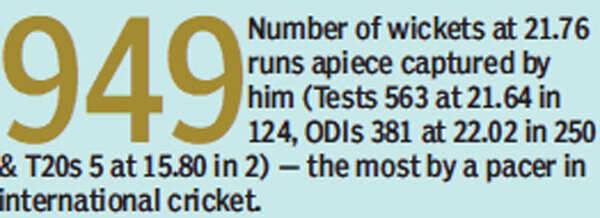
There's so much talk about his action. How much of a toll does it take on his body?
It probably takes a little bit because to generate that pace, you have to put in more effort, especially off a short run. The thing that Jasprit has in his favour is the last few steps of his run up, he actually generates and powers through the crease, and then he's got a really good follow through.
You see guys with short run ups, they try to muscle it, do it all at the crease, and then they have a very short follow through. So the fact that Bumrah, sort of, powers through the crease in his last few steps and has a good follow through is what holds him in good stead. The fact he can come back in his second and third spells and bowl just as quickly is a testament to that.
Whether if he had a longer run, yeah, it may save that little extra energy every ball - maybe, maybe not, maybe he wouldn't be able to bowl as well, who knows? But that's how he works at his best and I think he had a couple of years or more without any injury. So that itself tells me his action's fine. So whether he had an opportunity to have an offseason and put a bit of strength back in, I don't know. But he's a quality bowler and he is definitely unique, but he's found something that works for him.
Why were you nicknamed pigeon?
I was playing a game for New South Wales. And there were a couple of guys Brad McNamara, who played a lot of cricket for New South Wales and Greg Matthews, and Mike Whitney, who played for Australia. I think all three of them have taken credit for that nick-name. But they'll carry on saying that my legs were that skinny that they resembled a pigeon's.
So a stupid comment like that and it's stuck ever since. And that's been my nick-name. Before that it was Millard. And that was only because when I moved to Sydney, I lived in a caravan. And the type of caravan I lived in was a Millard. So not two very strong, aggressive names for a fast bowler. But you can't pick your own nick-name. And it's just one of those things that stuck.

What kind of a role does biomechanics play?
It didn't play a huge role. Back then it was there more for people who were injured and coming back from injury or who had actions that meant the possibility of getting injured but I think it's important to a degree that slowly your hips and your shoulders are in line when you bowl and your energy's going forward towards where you want to bowl and everything's pretty well.
Everyone's got to have it. Everyone's got their own action. We don't want robots running in bowling exactly the same, but the basics are all very similar. So biomechanics are important. But if you've got the perfect action, and you can't take a wicket, or you've got the worst action in the world, you can bowl all day at top pace, never get injured and you take heaps of wickets, who cares?
And there's the thing about multiple formats…
Yep. I quite enjoy playing all three formats, even though I played only a handful of T20 matches. They all require a different thought process, different planning.
If you can land the ball where you want to land it 99 times out of a 100 then you're going to be successful. In a Test match it's about building pressure, getting that ball in that same spot. T20 cricket is about containment. And then at the death, being able to bowl slow balls, bowl yorkers.
You've got to be able to mix it up. Three yorkers, two slow balls, a bouncer and a wide length ball. Yeah, it's all about execution.

You think The Hundred starting next year will succeed...
It's interesting. I'm curious why they decided to bring a total new format with new rules. And maybe it's the English trying to do something. But it's going to be interesting to see how it goes.
I am very much a traditionalist. Test cricket is still the ultimate for me. I enjoy One-day cricket and Test cricket. I understand T20 cricket is quick, it's exciting. It's about bringing people to the game. And if we can bring more people to cricket then it's great. Hopefully, that will filter up to Test cricket. The Hundred it's basically another format similar to T20 but with only 100 balls. So yeah, that's changing the fabric of the game.
Does it add to the complications to an already complicated game?
If we bring in The Hundred as well, you've got Test cricket, you've got One-day cricket, you've got T20 cricket, and now you've got 100-ball cricket. Now try explaining that to an American who can't understand cricket.
Cricketers are hero-worshiped in India. Do you think there is a fear of failure among them because of the kind of pressure to perform?
Here in India definitely but back home we are just normal people. I could walk around the streets back home and nobody worries me. Even Sachin went for a walk there recently and nobody bothered him. He could probably walk down the street without too many issues.
So they do hold their sportspeople in Australia in high regard. But not like cricketers here in India. Yeah, cricketers are superstars over here. And even for visiting cricketers. I suppose there is more pressure on the cricketers over here. If Australia loses, there's not too much fuss back home or maybe just a little bit. Whereas over here, it's, you know, when you've got 1.3 or 1.4 billion people. It's a little bit more pressure than 25 million people. Yes, there's more pressure on Indian cricketers. But the rewards are a lot more than anyone else.
You faced the brunt of Indian fans when you got Sachin out with that LBW in Adelaide. You also apparently got death threats after Darryl Harper gave him out…
Yeah, it's a shame that they didn't have the DRS back then. So what had happened there was that Sachin had just come in. I don't think he had scored at that stage. He was still on zero. I tried to bowl a bouncer and unsettle him. And it didn't get up. It kept low. And Sachin is not the tallest player at the best of times. And he ducked and the ball hit him on the shoulder. And from where I was looking, I thought it's hitting the stumps. I could see the bails over his head. So I appealed and the umpire gave it out. I still think it's out. Sachin still thinks the ball was clearing the stumps by a ball and a half. So back in the old days when the umpires gave it out, that was it.
Then we went to Melbourne and Sydney for the Tests yeah, I got a few death threats. I had security. My family had security in Sydney because Cricket Australia received death threats for me, because I got Sachin out. It was an unusual freak dismissal.
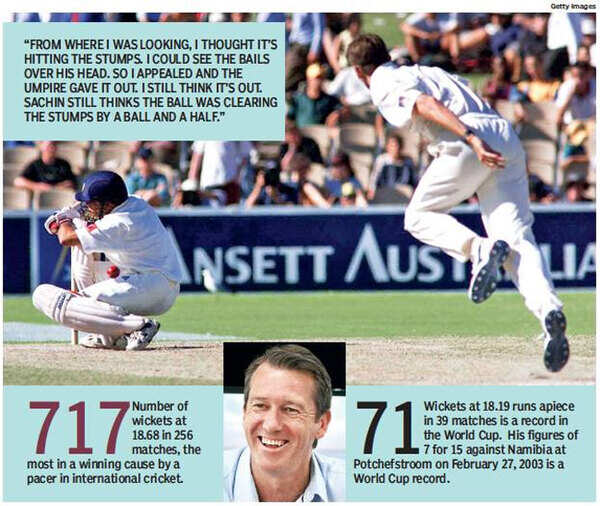
Did you discuss it with Sachin in your meetings with him after all these years?
We had a function few years back at MRF where Sachin came and spoke to the boys and then we had a Q&A session and one of the questions was about that dismissal, and I was still adamant it was out. He too was sure about it and said he was not out. Some people said you've got to get hit in the leg to be leg before wicket and shoulder doesn't count (laughter).
You have never been a fan of DRS?
I would have probably taken more wickets with it. When the DRS first came in, I was also a fan of it. I liked it, but now that I've seen it in use, and it's used for everything, but the way it was designed for, and I guess that's human nature isn't to find different ways to do things. And DRS now is a tactic.
Yeah, you're going to win and lose Test matches based on how well or how badly you used DRS. And I disagree with that. But that's modern-day cricket. Until we get it in exactly black and white, which I don't think we ever will, there will be issues.
How concerned are you about the health of Test cricket? Do you still feel there's a viewership for it among cricket fans?
I like to think there is. I speak to a lot of Australian cricketers and they still hold it in high regard. I think English cricketers think the same too. If Indians love Test cricket, it will survive at the end of the day, just because of the passion and the sheer number of people and how they feel about cricket in this country. So, when T20 cricket first came about, I was concerned that it would have a negative impact on Test cricket. And I remember in the second Indian Premier League in South Africa, I was sitting having a chat with Matthew Hayden, and I mentioned my thoughts and he said he actually looked at it from a different perspective. He thought T20 cricket had the potential to bring new people that don't watch cricket to the game, had the potential to take cricket to countries that don't play cricket. And it was a way that we could really grow the game. And once these people got interested in cricket, it would filter up to Test cricket. So I think that's a real possibility, but it's going to depend on the on the Boards and on the players themselves. If you've got young cricketers coming through still wanting to represent the country playing Test cricket, then I think it'll be healthy. If young cricketers just want to play T20, or go for the dollar, the glamour and everything else that goes with it, it may struggle a little bit, but we've got to keep it fresh and moving forward.
I'm not a big fan of the idea of having four-day Tests. I like the five days but I do like the day-light Test cricket. I think the way it's worked in Australia and the way it was supported, and the way people have come to the game. I think that's one way we can keep Test cricket moving forward and keeping it fresh and alive and, and I'm happy that Virat's agreed to play the Day-Nighter in Adelaide, later this season.
What are the lessons you take from the ball tampering saga?
It's interesting. We've always shined the ball. And I think that's the limit. I don't agree with rubbing the ball on the ground. I don't agree with putting mints on the ball. What happened in South Africa is definitely the wrong thing to do. It's up to the ICC to make a ruling on that and to be similar across the board. I know the Australians learnt a hard lesson. Hopefully other countries have as well.
Who do you think among the current crop are the top three bowlers?
All Aussies. Pat Cummins, Josh Hazelwood and Mitchell Starc. (Laughter). But seriously, Pat Cummins, Jasprit Bumrah and Kagiso Rabada. I like Neil Wagner too.
Aussie sport sometimes is seen as overly aggressive. Do you think that's a characteristic they should retain?
It's the Australian way. As players, we've probably don't look overly aggressive. We play hard in the middle. But it's always been a mantra to play hard but fair and as soon as you walk off the field, you're mates again.
If you think Australians play hard against other countries, wait till you see Australia play Australia or mates play against mates. Then you've got some aggression. You want to see good, hard cricket.
Look at the way Virat goes about it. I want people to go out and show emotion. I like aggression but controlled aggression. I don't want to see robots running around showing no emotion. But there is a fine line there. And we have to keep to that line.
A few people said I was quite aggressive when I played. I think there's a line there that should never be crossed. Bit of chat is fine. When it comes to abuse or getting personal, there's no spot for that in world cricket, or any cricket at all, but a little bit of friendly banter is always good.
Sledging, I think is the wrong term. It just sounds bad. And it's never as bad as anyone says it is. So we should use Steve Waugh's term which is gamesmanship or mental disintegration (laughs).
The Aussie team in the early 2000s was one of the greatest. Did you'll have any realisation that you'll were something great. What was the feeling in the dressing room?
I guess yeah, while you're playing, you'd never consider yourself a great team or anything like that. But there were some big personalities in that team and any one of the 11 or 13, on the day could win the game. And that's fairly rare. Most teams had two or three guys that have that X Factor. I think that Australian team then had the whole team and a really close knit team. And I think one of the secrets to our success was, not only did we enjoy our own success, we enjoyed our teammates success just as much. And if you've got that in a sports team or a business team, you're going to be successful. We backed ourselves and never feared losing. In the changing room it was good. We had Warnie (Shane Warne). He was here (high level) while the rest of us were here (mid-level). We accepted that. I think Shane accepted that and we got along well.
Brian Lara scored more runs in Australia when you and Shane Warne were both in the eleven than Tendulkar. Was he harder to bowl to?
That was Brian. He never changed his game. I may have got him out 15 times, but he also scored big hundreds and double hundreds against us when both me and Warnie were playing together for Australia. When it was his day, he could do absolutely anything. Sachin was equally as good, but there was something about Brian where he could just keep going and he was slightly harder to bowl to than Sachin. He was more fearless.
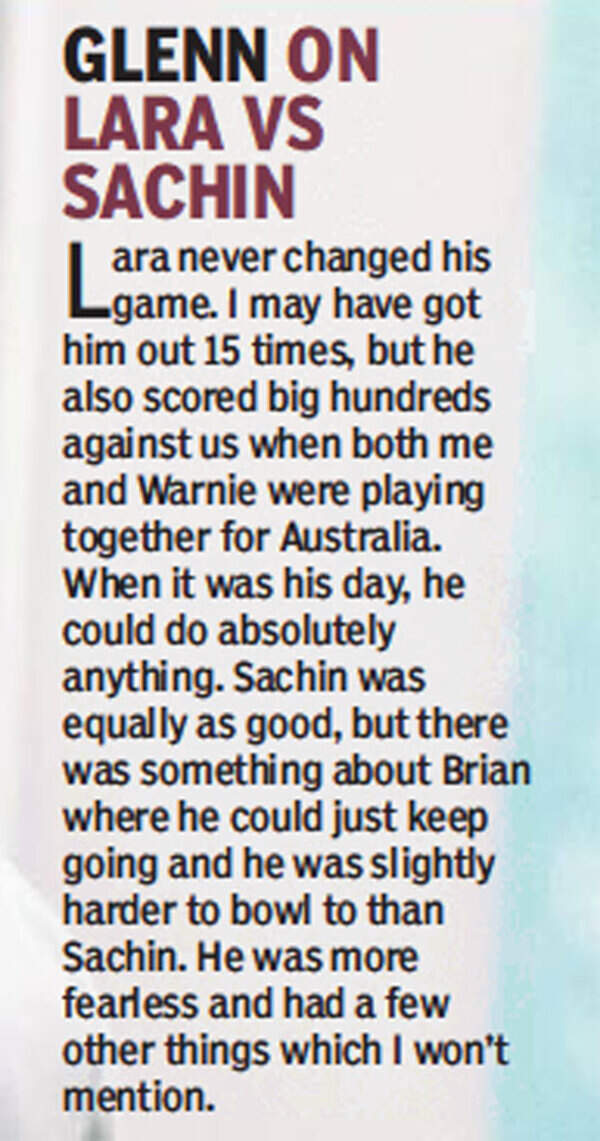
End of Article
FOLLOW US ON SOCIAL MEDIA




